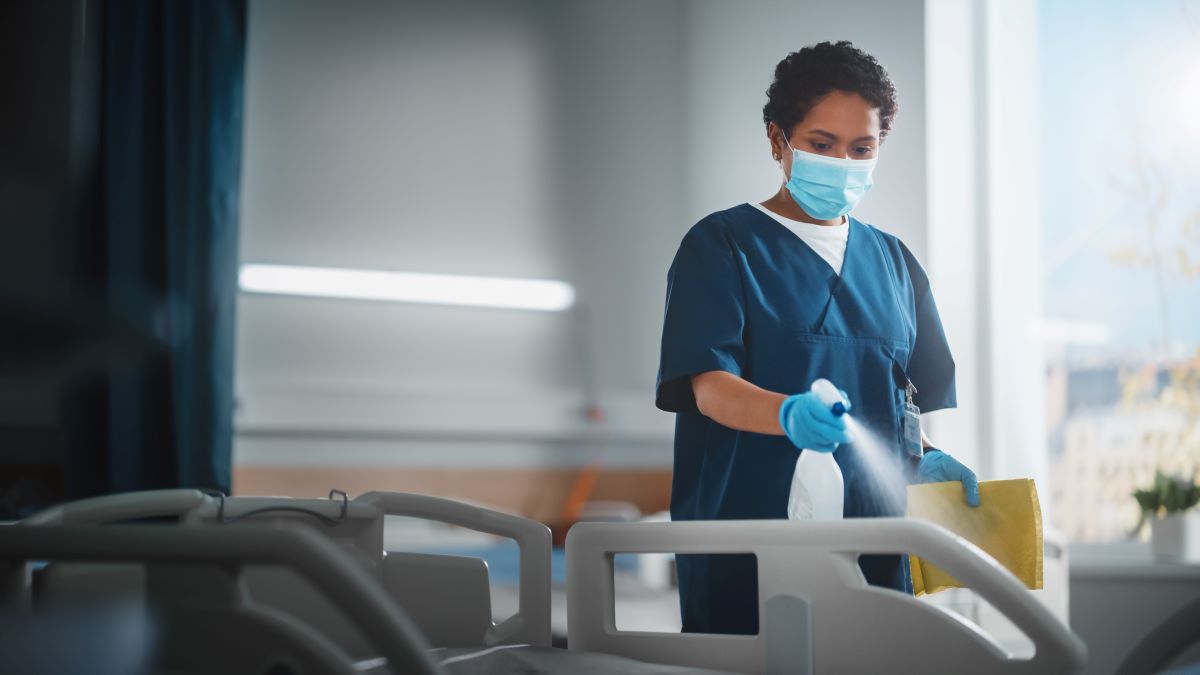Standard Precautions and Infection Control: Facility Guide

Infection control prevents healthcare-acquired infections while protecting frontline staff delivering care. For an infection control program to be effective, healthcare leaders must provide staff with adequate education, training, and resources to minimize risk.
We share the elements of standard precautions for infection prevention outlined by the Centers for Disease Control and Prevention (CDC). Note that terminology for infection control protocols may vary by region. For example, in the UK healthcare professionals apply the “10 principles of infection control” to achieve similar results.
In this guide, you’ll find a helpful breakdown of the standard precautions used in the U.S. It covers the rationale for each category and examples for how to incorporate them into your organizational policies to support your overall compliance efforts.
What Is Infection Control?
Infection control allows healthcare organizations to incorporate policies and procedures to prevent and reduce infection rates. Hospitals in the U.S. began implementing infection control policies in the 1950s after recognizing the occurrence of healthcare-associated infections (HAIs), or infections acquired from getting care. Examples include central line-associated bloodstream infections (CLABSIs) or catheter-associated urinary tract infections (CAUTIs). HAIs cost the healthcare industry billions of dollars per year and affect one in 31 patients at any given time.
Healthcare organizations can create a culture of safety by incorporating an infection control department dedicated to preventing and reducing infections. Infection control committees are responsible for conducting surveillance of infection rates and preventing the spread of infectious agents through clinical policies and practice guides.
Your organization doesn’t need to create infection-prevention strategies from scratch — resources from the Healthcare Infection Control Practices Advisory Committee (HICPAC) are available to guide policies. The committee provides advice for infection control policies to federal organizations like the CDC and HHS about the prevention, surveillance, and control of HAIs in healthcare settings, including:
- Hospitals
- Long-term care facilities
- Outpatient settings
- Home health
What Are Standard Precautions for Infection Control?
Healthcare staff must assume every interaction in the practice setting — whether with patients, visitors, or other staff — carries a risk of infectious exposure. This practice, known as “standard precautions,” should be used for all patient care. Within the guidelines, there are eight elements to guide clinical decisions, such as how to maintain a clean environment and handle medical equipment.
When caring for a patient with a recognized infection, healthcare staff follow transmission-based precautions in addition to standard precaution measures, which are categorized by route of transmission:
- Contact precautions are used for patients with a known or suspected infection that can be spread by touch, such as methicillin-resistant Staphylococcus aureus (MRSA).
- Droplet precautions are followed when germs may be spread through coughing or sneezing, such as influenza.
- Airborne precautions are used for pathogens that are spread through the airborne route, such as measles or chickenpox.
Healthcare workers also take precautions to prevent exposure to bloodborne pathogens, such as HIV and Hepatitis B, during patient care. This practice, which includes the safe handling of needles and bodily fluids, is known as “universal precautions.” The key difference between standard precautions vs. universal precautions is the risk of infection from bloodborne pathogens.
8 Key Elements of Standard Precautions
What are the CDC’s standard precautions recommendations designed to do? They serve as a guideline to help drive clinical decisions in the healthcare setting. Below are the essential components of infection control according to the CDC’s guidelines. When establishing policies for staff, consider organizational policies, CMS regulations, and other occupational safety standards that weigh into practice guidelines.
1. Perform Hand Hygiene
Hand-washing is one of the most effective ways to prevent the spread of infection in the healthcare setting. Staff training on proper handwashing should include information about:
- When to use soap and water vs. alcohol-based sanitizer
- Frequency and duration of hand-washing
- Hand-washing before sterile procedures
Example: Annual staff training that includes a training course about hand hygiene for healthcare workers.
2. Wear Personal Protective Equipment (PPE)
Any time there’s an expectation of possible transmission of infection, staff should don appropriate PPE. Facility policies direct staff to place patients on isolation precautions based on the type of infection suspected or recognized.
Example: A patient with four days of consistent diarrhea is tested for C. diff. While the test results are pending, the nursing staff places the patient on contact isolation. This alerts visitors and staff to don appropriate PPE and use soap and water for handwashing when exiting the room.
3. Practice Respiratory Hygiene
Practicing respiratory etiquette when coughing or sneezing prevents the spread of infection through droplets. Facilities can post educational reminders to “cover your cough” and provide visual demonstrations of sneezing etiquette. Place alcohol-based sanitizer throughout public spaces to encourage hand hygiene when coughing or sneezing.
Example: During hospital orientation, new hires watch a video on sneezing etiquette.
4. Patient Placement
When deciding where a patient is placed within a facility or unit, decision-makers must take into account any infection risks. For example, a patient with a recognized infection should be placed in a single room instead of a shared room. Facility-based policies about patient placement can be informed by CDC’s guidelines for isolation precautions.
Example: A patient with a suspected tuberculosis infection needs to be admitted to a medical floor, but there are no beds available. The surgical floor accepts the patient into a negative-pressure respiratory isolation room while TB is ruled out.
5. Clean and Disinfect Equipment and Environment
Maintaining a clean environment is the responsibility of all healthcare staff — not just environmental services staff. Policy guides should inform staff which equipment is classified as single-use, single-patient use, or reusable. Staff can do their part to maintain a clean environment by:
- Disinfecting high-touch surfaces in patient rooms and shared workspaces
- Cleaning reusable equipment between patients
- Sending equipment to the sterile processing department as appropriate
Example: A patient is discharged after being treated for a maggot-infested wound. The environmental services team member follows CDC’s best practices for environmental cleaning when turning the room over. Due to the nature of the infection, a “high clean” is performed and all unused medical supplies in the room are discarded.
6. Handle Textiles and Laundry Properly
Another way to protect patients is to prevent the spread of infection through bed sheets and patient gowns. Clean linens must be stored in a clean, designated place. Dirty linen should be discarded in a designated area. Facility policies should indicate the process of laundering linens exposed to infectious pathogens.
Example: An infection control team member performs periodic audits of the supply room to ensure proper storage of clean linens.
7. Follow Safe Injection Practices
Practicing needle safety protects patients from exposure to germs during an injection — and protects staff from exposure to blood and bodily fluids. Healthcare leaders should create policies that guide staff in preventing unsafe injection practices, including:
- Never reusing an insulin pen on more than one person
- Wearing a mask during lumbar punctures (spinal taps)
- Never reusing a fingerstick device on more than one person
Example: A nurse has two patients with the same type of insulin coverage. Instead of reusing the same insulin pen for both patients, the nurse uses single-patient devices sent from the pharmacy.
8. Ensure Healthcare Worker Safety With Sharps
Consider including education on the safe use of needles and other sharps during initial and annual staff training. In addition to needlestick prevention, staff should know what to do in the case of an accidental needle stick. Healthcare leaders can refer to occupational safety standards for navigating bloodborne pathogen exposure incidents in the clinical setting.
Example: A DON is tasked with revising a sharps injury prevention program at a nursing home after seeing an increase in accidental needle sticks. The leader follows suggestions from the sharps safety for healthcare settings workbook to evaluate and revise existing policies.
Learn More Ways to Promote Patient Safety
Now that you know the standard precautions definition and how it’s applied, you may want to learn more ways you can promote a culture of safety in your organization. Get regular updates on the latest evidence-based practice standards, and more, in IntelyCare’s free newsletter.
